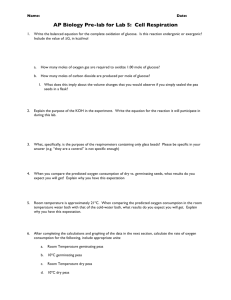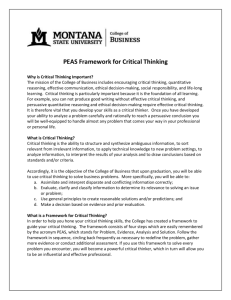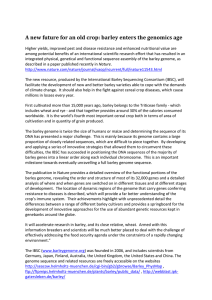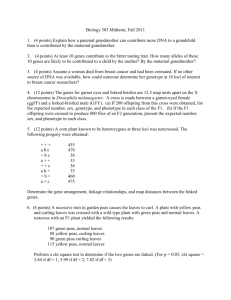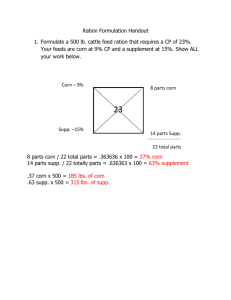Nitrogen Content of Green Manure Crops Summary
advertisement
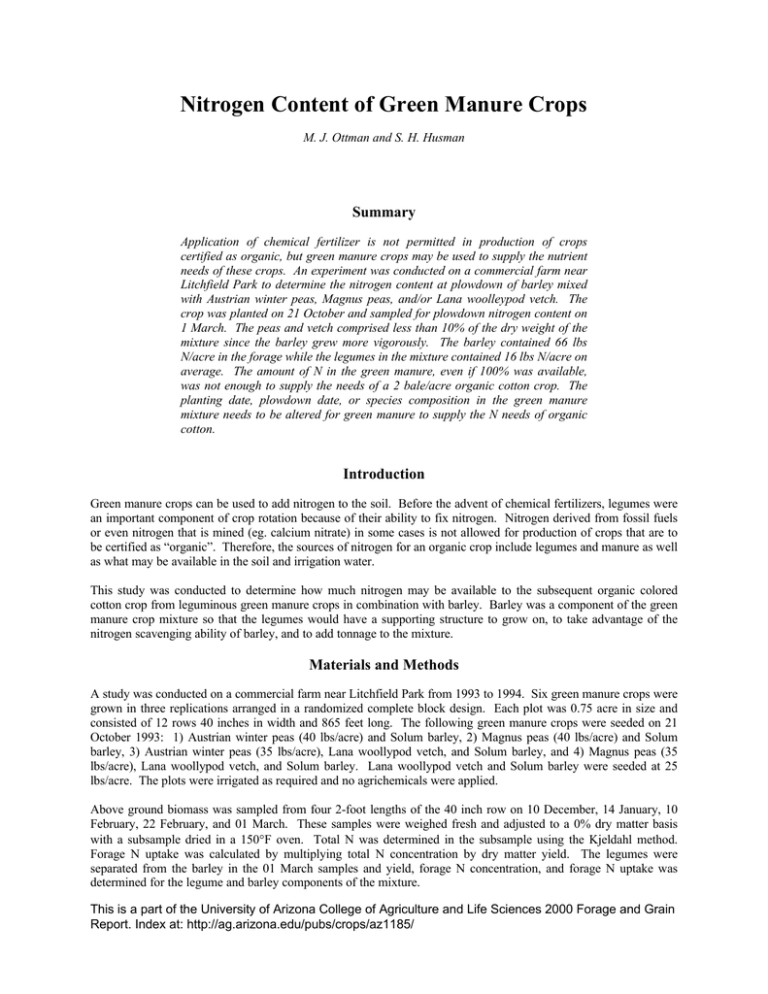
Nitrogen Content of Green Manure Crops M. J. Ottman and S. H. Husman Summary Application of chemical fertilizer is not permitted in production of crops certified as organic, but green manure crops may be used to supply the nutrient needs of these crops. An experiment was conducted on a commercial farm near Litchfield Park to determine the nitrogen content at plowdown of barley mixed with Austrian winter peas, Magnus peas, and/or Lana woolleypod vetch. The crop was planted on 21 October and sampled for plowdown nitrogen content on 1 March. The peas and vetch comprised less than 10% of the dry weight of the mixture since the barley grew more vigorously. The barley contained 66 lbs N/acre in the forage while the legumes in the mixture contained 16 lbs N/acre on average. The amount of N in the green manure, even if 100% was available, was not enough to supply the needs of a 2 bale/acre organic cotton crop. The planting date, plowdown date, or species composition in the green manure mixture needs to be altered for green manure to supply the N needs of organic cotton. Introduction Green manure crops can be used to add nitrogen to the soil. Before the advent of chemical fertilizers, legumes were an important component of crop rotation because of their ability to fix nitrogen. Nitrogen derived from fossil fuels or even nitrogen that is mined (eg. calcium nitrate) in some cases is not allowed for production of crops that are to be certified as “organic”. Therefore, the sources of nitrogen for an organic crop include legumes and manure as well as what may be available in the soil and irrigation water. This study was conducted to determine how much nitrogen may be available to the subsequent organic colored cotton crop from leguminous green manure crops in combination with barley. Barley was a component of the green manure crop mixture so that the legumes would have a supporting structure to grow on, to take advantage of the nitrogen scavenging ability of barley, and to add tonnage to the mixture. Materials and Methods A study was conducted on a commercial farm near Litchfield Park from 1993 to 1994. Six green manure crops were grown in three replications arranged in a randomized complete block design. Each plot was 0.75 acre in size and consisted of 12 rows 40 inches in width and 865 feet long. The following green manure crops were seeded on 21 October 1993: 1) Austrian winter peas (40 lbs/acre) and Solum barley, 2) Magnus peas (40 lbs/acre) and Solum barley, 3) Austrian winter peas (35 lbs/acre), Lana woollypod vetch, and Solum barley, and 4) Magnus peas (35 lbs/acre), Lana woollypod vetch, and Solum barley. Lana woollypod vetch and Solum barley were seeded at 25 lbs/acre. The plots were irrigated as required and no agrichemicals were applied. Above ground biomass was sampled from four 2-foot lengths of the 40 inch row on 10 December, 14 January, 10 February, 22 February, and 01 March. These samples were weighed fresh and adjusted to a 0% dry matter basis with a subsample dried in a 150°F oven. Total N was determined in the subsample using the Kjeldahl method. Forage N uptake was calculated by multiplying total N concentration by dry matter yield. The legumes were separated from the barley in the 01 March samples and yield, forage N concentration, and forage N uptake was determined for the legume and barley components of the mixture. This is a part of the University of Arizona College of Agriculture and Life Sciences 2000 Forage and Grain Report. Index at: http://ag.arizona.edu/pubs/crops/az1185/ Results and Discussion The legumes in the mixture were slow to establish and were not vigorous compared to the barley. The legumes comprised less than 10% of the mixture at the 01 March sampling time (Table 1). In order for the legumes to be more competitive in mixture with the barley, the trial should have been planted a few weeks earlier, the barley should have been seeded at a lower rate, and/or the trial should have been extended another month. Solum barley was at the soft dough stage on 01 March and near the peak of dry matter accumulation, while the legumes had just started their rapid period of growth and probably needed another month to reach peak dry matter (and N) accumulation. However, the green manure crop needed to be terminated on 01 March in order to plant the cotton at an optimal time. Delaying the cotton planting date would have resulted in decreased cotton yields. The N requirement of cotton is approximately 60 lbs N/acre per bale. If our yield goal for organic cotton is 2 bales/acre, then 120 lbs N/acre is required. The N content of the green manure crops averaged 82 lbs N/acre, but not all of this N would be available to the subsequent crop. Since the average N concentration in the green manure was less than 1.5%, a temporary depression in soil nitrate content to break down the straw in the barley is likely. Therefore, the actual amount of N available from the green manure crop is probably much less than 82 lbs N/acre. In order for a leguminous crop to supply N to a subsequent cotton crop, either the legume needs to mature earlier either by choosing other species or by manipulating planting date, or the cotton needs to tolerate later planting. Acknowledgements The cooperation of Mike Moore, the grower, is greatly appreciated. Table 1. Forage species mixture and yield, nitrogen concentration, and nitrogen uptake in the forage at various sampling dates. The effect of the mixture of plant species on yield and forage N was not statistically significant at any sampling date. Sampling date Barley growth stage 10-Dec 4 leaf Austrian winter peas/Barley Magnus peas/Barley Austrian winter peas/Barley/Vetch Magnus peas/Barley/Vetch AVERAGE 295 468 333 374 367 2.99 3.11 3.41 3.02 3.13 9.0 15.2 11.6 11.7 11.9 14-Jan Jointing Austrian winter peas/Barley Magnus peas/Barley Austrian winter peas/Barley/Vetch Magnus peas/Barley/Vetch AVERAGE 1357 2007 1836 1621 1705 1.96 1.90 1.70 2.35 1.98 28.1 39.0 31.3 37.6 34.0 Flowering Austrian winter peas/Barley Magnus peas/Barley Austrian winter peas/Barley/Vetch Magnus peas/Barley/Vetch AVERAGE 3224 3815 3949 4208 3799 1.43 1.64 1.46 1.41 1.48 46.6 68.3 59.9 59.4 58.5 10-Feb Plant species Oven dry forage yield lbs/acre Forage Forage nitrogen nitrogen concentration uptake % lbs N/acre 22-Feb Milk Austrian winter peas/Barley Magnus peas/Barley Austrian winter peas/Barley/Vetch Magnus peas/Barley/Vetch AVERAGE 4096 5064 4686 5347 4799 1.25 1.54 1.34 1.61 1.44 49.5 76.5 63.9 91.2 70.3 01-Mar Soft dough Austrian winter peas/Barley Magnus peas/Barley Austrian winter peas/Barley/Vetch Magnus peas/Barley/Vetch AVERAGE 5078 5481 6570 6912 5785 1.23 1.54 1.60 1.38 1.44 61.2 88.7 90.6 88.4 82.2 01-Mar Soft dough Barley (in Austrian winter peas) Barley (in Magnus peas) Barley (in Austrian winter peas/Vetch) Barley (in Magnus peas/Vetch) AVERAGE 4682 4888 5310 6294 5294 1.05 1.34 1.43 1.11 1.23 48.1 71.7 76.8 67.5 66.0 01-Mar Soft dough Austrian winter peas (in Barley) Magnus peas (in Barley) Austrian winter peas/Vetch (in Barley) Magnus peas/Vetch (in Barley) AVERAGE 396 593 360 618 492 3.16 2.79 3.84 3.32 3.28 13.1 17.0 13.9 20.9 16.2


